Can ACL Tears Heal Themselves Without Surgery?
 Recent research has sparked debate in the medical community about the treatment of Anterior Cruciate Ligament (ACL) injuries, traditionally believed to require surgery for effective healing.
Recent research has sparked debate in the medical community about the treatment of Anterior Cruciate Ligament (ACL) injuries, traditionally believed to require surgery for effective healing.
 A study published in the British Journal of Sports Medicine suggests that nonsurgical treatments, particularly a new bracing protocol combined with physical therapy, could be as effective as surgery.
A study published in the British Journal of Sports Medicine suggests that nonsurgical treatments, particularly a new bracing protocol combined with physical therapy, could be as effective as surgery.
This study found that 90% of ACL tears in 80 participants showed signs of healing after following this protocol.
The ACL, crucial for knee stability, is one of the most commonly injured knee ligaments, especially in sports involving sharp movements or direct impacts.
Traditionally, surgery, which involves replacing the torn ligament with a graft, is the recommended treatment.
However, surgical interventions are not without risks, such as knee pain, instability, stiffness, and even complications like infections and blood clots.
The new bracing method involves keeping the knee at a 90-degree angle, believed to increase the likelihood of the torn ACL ends fusing. This approach is likened to stabilizing broken bones in a cast.
The patients then undergo physical therapy while the braces are adjusted to increase the range of motion, with the braces removed around the three-month mark. Follow-up MRIs revealed significant healing in most cases.
This method could be particularly beneficial for individuals who cannot undergo surgery due to financial or health reasons, or for those not in professional sports.
The research also raises questions about the necessity of surgery, especially given that ACL reconstruction does not guarantee prevention of osteoarthritis, a common long-term complication of ACL tears.
While the study showed promising results, it also noted that:
14% of participants re-injured their ACL. This raises concerns about the long-term stability and safety of nonsurgically treated ACL injuries, especially for athletes who may return to high-demand sports.
Orthopedic surgeons like Dr. Lutul Farrow and Dr. Riley Williams express skepticism, emphasizing the importance of surgery for complete tears, especially in athletes. They argue that bracing may not provide the stability needed to prevent future injuries, such as meniscus tears or another ACL injury, which can lead to increased risks of osteoarthritis.
Despite these concerns, the study offers a potential alternative to surgery, particularly for non-athletes or those with contraindications to surgery.
It highlights the need for further research and consideration of individual patient circumstances in deciding the best treatment approach for ACL injuries.
Read the full story.
![HR Logo [Recovered]_Full Color Vertical-1](https://blog.healthyroster.com/hs-fs/hubfs/HR%20Logo%20%5BRecovered%5D_Full%20Color%20Vertical-1.png?width=199&height=178&name=HR%20Logo%20%5BRecovered%5D_Full%20Color%20Vertical-1.png)
 By
By


